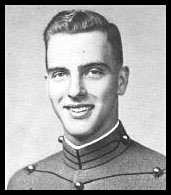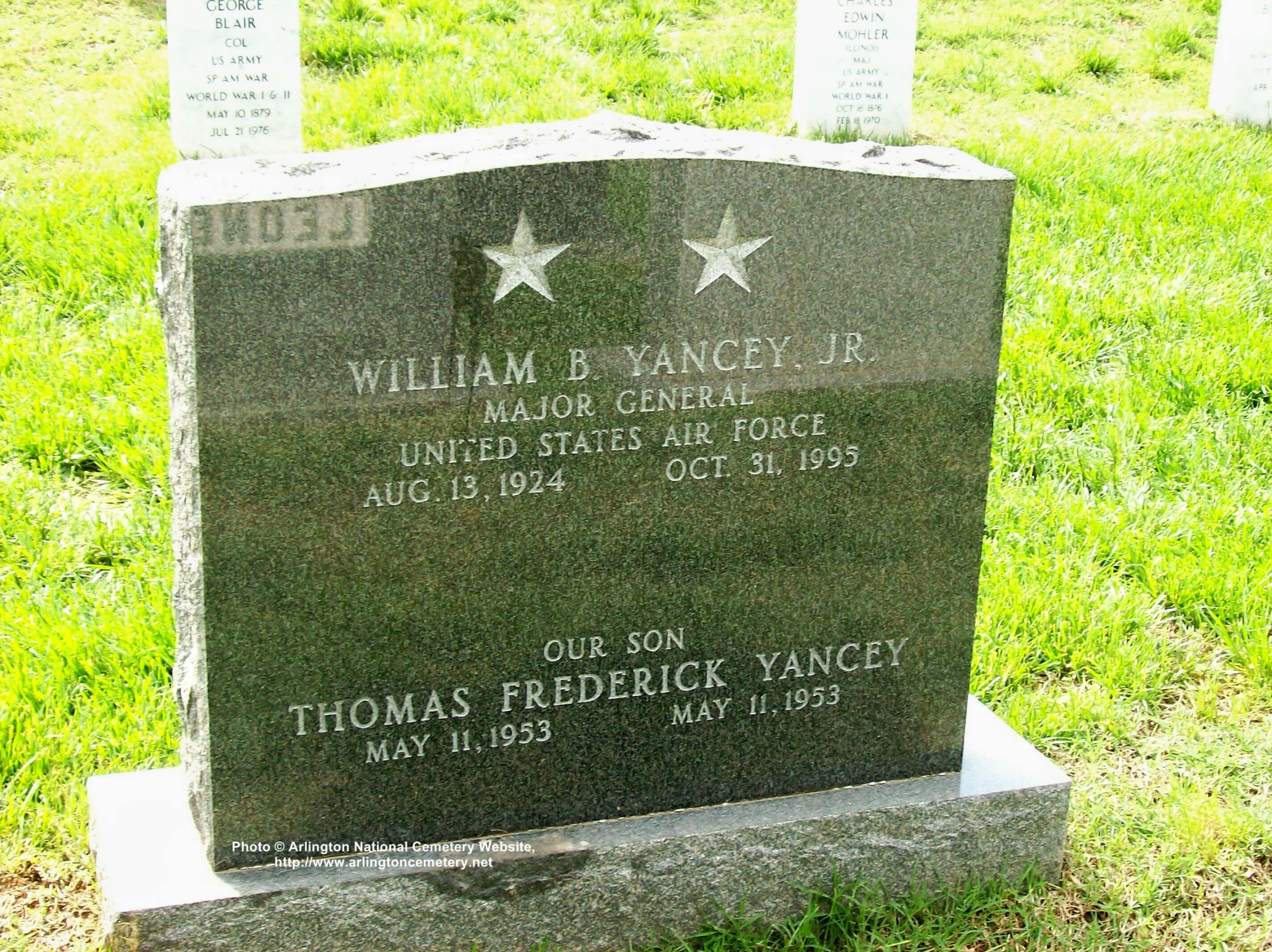Courtesy of his classmates, United States Military Academy, Class of 1946
William Burbridge Yancey, Jr.
No. 16000 Class of 1946
Died 31 October 1995 at Andrews AFB, Maryland, aged 71 years.
Interment: Arlington National Cemetery, Arlington, Virginia.
Bill was born 13 August 1924 in Berwyn, Maryland. His father, a regular Army officer (Infantry) was stationed at Fort Meade at the time. Bill graduated from Fayetteville High School in North Carolina, won a Presidential appointment and joined the class of 1946 at West Point on 1 July 1943.
Bill recalled that the most important event in his cadet life was meeting Phyllis Vander Fehr. Bill noted she was the prettiest thing in the world. Classmate, Jim Carbine recalled: “Phyllis worked in the Treasurer’s Office in Washington Hall. Those of us on the second floor front of the 19th Division had many opportunities to observe her and after we got to know her yell ‘Hi’ out the window as she walked home from work each day. We thought we had a chance to date her and were disappointed when she started to drag Bill Yancey. It was love at first sight for both because he was the only one in her life after that.” Bill played tackle on the famous Army football team of that era. He opted for flight training and pinned on the wings and bars of a second lieutenant, Army Air Corps at graduation. Bill and Phyllis were married at West Point on 5 June 1946.
Some years ago, Bill prepared a synopsis of his life and wrote of his early assignments:
“First assignment was Williams Field, Arizona for P-51 training. Then assigned to 20th Group (P-51s) at Shaw Field, Sumter, SC. Transferred to Okinawa in 1948, flying P-80’s. Rotated to the States in July 1950 to 334th Fighter Intercept Squadron at New Castle, Delaware. In November, the unit, equipped with F-86 Sabre jets, moved by aircraft carrier to Japan and ultimately to Korea to fight the MIG’s. [Bill was credited with 1 ½ air victories and won the DFC] Returned to the States in July 1951 to Selfridge AFB, Michigan. From Selfridge, we moved to the Air Force Academy temporarily at Lowry AFB, Denver, Colorado.
One of Bill’s best friends, Lieutenant General Arnold Braswell, USAF, Retired. (USMA ’48), recalled Bill’s contributions to the Air Force Academy: “As the Air Officer Commanding of a cadet squadron and later a group, Bill helped establish the high standards of honor, esprit, commitment and discipline that became woven into the fabric of the cadet wing. He guided the first classes of cadets, as OIC of the Cadet Honor Committee, toward development and acceptance of a strong honor code modeled after West Point. His fellow officers and the cadets of that era developed the highest regard for his leadership and great admiration for him as a warm and caring human being.”
Bill continued telling of his assignments: “In 1958, we moved to Europe where I was Operations Officer for the 32nd Fighter Squadron, flying F-100’s and F-102’s in Holland. From Holland followed the Armed Forces Staff College, Langley AFB, Virginia, Air War College and the Pentagon. In 1968, I was named Vice Commander of the Fighter Weapons Wing at Nellis AFB, Nevada and then moved to Myrtle Beach AFB, SC to become the 113th Tactical Fighter Wing (TFW) Commander. Went to Vietnam in 1969 to command the 31st TFW at Tuy Hoa Air Base (F-100’s). Returned to the States in 1970 to Air Force Plans in the Pentagon, promoted to Brigadier General in 1972 and assigned to the J-5 Directorate of Joint Staff. Promoted to Major General and assigned to USECOM in 1974. In 1976, I became Vice Commander, 16th Air Force, Torrejon Air Base, Madrid, Spain. Retired in 1978.”
Bill loved to tell of his retirement. At that time, classmate Lew Allen was Chief of Staff, US Air Force and classmate Bill Evans was CINCUSAFE. So, on the occasion of Bill’s retirement, Lew Allen and Bill Evans came to Spain to retire Bill Yancey, then the three of them went to Ramstein, Germany where Lew retired Bill Evans and all three flew back to the United States.
After retirement, Bill and Phyllis became active in residential real estate. Bill also became a volunteer “enrolled agent” of the IRS to assist elderly people and others
with their taxes, and was a lay eucharistic minister at St. Rita’s Catholic Church.
Arnold Braswell, wrote of the last phase of Bill’s life: “A good athlete, Bill enjoyed
playing squash and tennis until he was afflicted in 1991 with a painful and puzzling illness, eventually diagnosed as rheumatoid arthritis. Though he suffered greatly from this disease for more than four years, he retained his famous sense of humor and his unquenchable spirit. Characteristically, he consulted every medical reference he could find and, to the dismay of his physicians, could debate with them about possible new treatments. Ultimately, the disease was a factor in his death, causing complications which prevented his successful recovery from surgery. He died 31 October 1995 in the Malcolm Grow Medical Center at Andrews AFB, Maryland. He is survived by his wife, Phyllis; a son William III; two daughters, ary Jo and Annette; and a twin sister, Mary.”
Air Force classmate, Bob Stewart wrote: “Bill’s tennis game pretty well reflected his tenacity and competitive drive. As a dedicated dunker, I could yank him around the court. I’d have him scrambling and lunging in all directions, but somehow I’d end up on the short end of the score. He never quit.”
Another Air Force classmate, Lieutenant General Kenneth L Tallman, Retired, wrote: “Through the years of his Air Force career and beyond in retirement, his outgoing personality, winning sense of humor, strong integrity and sincere concern and compassion for his fellow man were the hallmarks of his life. Even those who knew Bill only slightly were quick to recognize his real humanitarian kindness.”
Finally, Arnold Braswell wrote: “He was one of those rare persons we all admire and would like to emulate – wise, compassionate, infinitely moral and totally without ego. He had a great sense of humor, frequently sharing new jokes or relating humorous anecdotes about himself. Perhaps his most admirable quality was that he always cared more for others than for himself. He enjoyed helping others and devoted much of his time to doing so. Bill epitomized the committed, caring leader which the Academy strives to develop. None of us who came to know and love this exceptional human being will ever forget him and we mourn his passing.”
The Class of 1946 joins the family and friends of Bill Yancey to state proudly; “Well Done, Bill; Be Thou At Peace!”
‘466 Memorial Article Project and his wife, Phyllis
Courtesy of the United States Air Force
MAJOR GENERAL WILLIAM B. YANCEY JR.
Retired August 1, 1978, Died October 31, 1995
Major General William B. Yancey Jr., was vice commander of the 16th Air Force, U.S. Air Forces in Europe, with headquarters at Torrejon Air Base, Spain. As vice commander, he is charged with exercising responsibility for U.S. forces located in Spain, Italy, Greece and Turkey.
General Yancey was born in Berwyn, Maryland, in 1924. He graduated from high school in Fayetteville, North Carolina, in 1942, and attended Virginia Military Institute for three months prior to entering the U.S. Military Academy, West Point, New York. He received flying training while at the academy and in 1946 was graduated with a commission as a second lieutenant in the U.S. Army Air Corps and received his pilot wings.
He attended fighter transition training at Williams Field, Arizona, in June 1946 and then was assigned as a pilot in the 20th Fighter Group and later the 77th Fighter Squadron at Shaw Field, South Carolina. He was transferred to Naha, Okinawa, in 1948 and served as a jet fighter pilot, flying F-80s with the 51st Fighter Group.
General Yancey returned to the United States in June 1950 for duty with the 334th Fighter-Interceptor Squadron, 4th Fighter Group, New Castle, Delaware. He moved with the group to the Republic of Korea in November 1950 and flew 59 combat missions in F-86s during the Korean War.
In July 1951 General Yancey was transferred to the 56th Fighter-Interceptor Group, Oscoda Air Force Base, Michigan, and later moved to the parent organization, the 4708th Defense Wing at Selfridge Air Force Base, Michigan, as assistant deputy commander for operations.
General Yancey became air officer commanding, Air Force Cadet Wing, in January 1955, and later of the 1st and 2d Groups at the U.S. Air Force Academy in Colorado Springs, Colorado.
General Yancey was transferred to Europe in August 1958 and became deputy director for operations, Headquarters 36th Tactical Fighter Wing, Bitburg Air Base, Germany, and later was operations officer, 32d Fighter-Interceptor Squadron at Soesterberg, The Netherlands.
He returned to the United States in August 1961 to attend the Armed Forces Staff College, Norfolk, Virginia, and after graduation in January 1962 was assigned as chief, Special Training Division, Directorate of Operations, Headquarters Tactical Air Command, Langley Air Force Base, Virginia. In August 1963 he entered the Air War
College, Maxwell Air Force Base, Alabama.
In July 1964 General Yancey was assigned to Headquarters U.S. Air Force, Washington, D.C., where he served as action officer, branch chief and assistant division chief in the Directorate of Plans, Office of the Deputy Chief of Staff for Plans and Operations. He became vice commander, 4525th Fighter-Weapons Wing, Nellis Air Force Base, Nevada, in July 1968, and was assigned as commander, 113th Tactical Fighter Wing, Myrtle Beach Air Force Base, South Carolina, in October 1968.
In August 1969 General Yancey was transferred to the Republic of Vietnam and assigned as commander, 31st Tactical Fighter Wing at Tuy Hoa Air Base. While on this assignment, he flew approximately 350 combat hours in the F-100. He returned to the Directorate of Plans at Headquarters U.S. Air Force in July 1970 and was assistant deputy director for force development until January 1972 when he assumed duty as deputy director.
General Yancey was assigned to the Organization of the Joint Chiefs of Staff as chief, Objective Plans and Military Assistance Division, in the Plans and Policy Directorate, in January 1973.
In August 1974 General Yancey was named director of plans and policy for the U.S. European Command in Stuttgart, Germany. He became vice commander of the 16th Air Force in June 1976.
He is a command pilot. His military decorations and awards include the Legion of Merit with two oak leaf clusters, Distinguished Flying Cross with oak leaf cluster, Air Medal with 14 oak leaf clusters, Air Force Commendation Medal, and the Distinguished Unit Citation Emblem with oak leaf cluster.
General Yancey was promoted to the grade of Major General on Aug. 1, 1974, with date of rank March 1, 1972.
Michael Robert Patterson was born in Arlington and is the son of a former officer of the US Army. So it was no wonder that sooner or later his interests drew him to American history and especially to American military history. Many of his articles can be found on renowned portals like the New York Times, Washingtonpost or Wikipedia.
Reviewed by: Michael Howard


